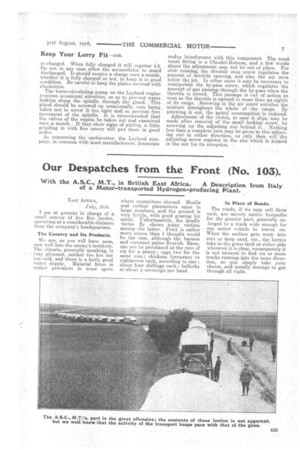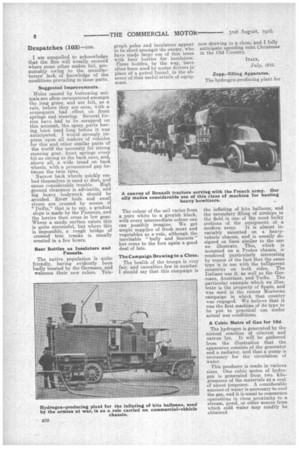Our Despatches from the Front (No. 105).
Page 7

Page 8

If you've noticed an error in this article please click here to report it so we can fix it.
With the A.S.C., M.T., in British East Africa. A Description from Italy
of a Motor-transported Hydrogen-producing Plant.
EA ST AFRICA,
July, 1916.
am at present in charge of a small convoy of five Rec. lorries, operating at a considerable distance from the company's headquarters.
The Country and Its Products.
We are., as you will have seen, now well into the enemy's territory. The climate, generally speaking, is very pleasant, neither too hot nor too cold, and there is a.fairly good water supply. Malarial fever is rather prevalent in some spots
where mosquitoes abound. Mealie* and rubber plantations exist in large numbers, and the ground is very fertile, with good grazing for cattle. Unfortunately, the deadly tsetse fly claims many victims among the latter. Fruit is rather more scarce than I thought would the the case, although the banana and cocoanut palms flourish. Bananas can be purchased at the rate of six for a penny ; eggs two for the same sum ; chickens fourpence to eightpence each, according to size ; sheep four shillings each ; bullocks at about a sovereign per head. In Place of Roads.
The roads, if we may call them such, are merely native footpaths for the greater part, generally enlarged to a track wide enough for one motor vehicle to travel on. When the surface gets worn into ruts or deep sand, etc., the lorries take to the grass land on either side wherever it is clear, consequently it is not unusual to find six or more tracks running into the same direction, so ' you simply take your choice, and usually manage to get through all right.
I am compelled to acknowledge that the Roo will usually succeed where some other makes fail, presumably owing to the manufacturers' lack of knowledge of the conditions prevailing in these parts.
Suggested Improvements.
Holes caused by burrowing animals are often encountered amongst the long grass, and are felt, as a rule, before they are seen, with a consequent bad effect en front springs and steering. Several lorries have had to be scrapped on this account, the spare parts hexing. been used long before it was anticipated. I would strongly. impress upon all makers of vehicles for this and other similar parts of the world the necessity for strong steering gear, front springs every bit as strong as the back ones, and, above all, a wide tread on back wheels, with a pronounced gap between the twin tires.
Narrow back wheels quickly embed themselves in sand or dust, and cause considerable trouble. High ground clearance is advisable, and big heavy bodywork should be avoided. River beds and small rivers are crossed by means of "Drifts," that is to say, a gradual slope is made by the Pioneers, and the lorries then cross in low gear. Where a sandy surface exists this is quite successful, but where this is impossible, a rough bridge of crossed tree trunks is usually erected in a few hours.
Beer Bottles as Insulators and Funnels.
The native .population is quite friendly, having evidently been badly treated by the Germans, and welcome their new rulers. Tele graph poles and insulators appear to be short amongst the enemy, who have made largeuse of thin trees with beer bottles for insulatons. These bottles, by the way, have often been used by motor deivers in ' place of a petrol funnel, in the absence of that useful article of equipment.
The colour of the soil varies from a pure white to a greyish black, with every intermediate colour one can possibly imagine. We get ample supplies of fresh meat and vegetables as a rule, although the inevitable "bully and biscuits" has come to the fore again a good deal of late.
The Campaign Drawing to a Close.
The health of the troops is very fair, and casualties few in number. I should say that this campaign is
now drawing to a close, and I fully anticipate spending next Christmas in the Old Country.
ITALY,
July, 1916.
Zepp.-filling Apparatus.
The hydrogen-producing plant for
the inflating of kite balloons, and the seeondary filling of airships in the field is one of the most bulky sections of the equipment of a modern army. It is almost invariably mounted on a heavyvehicle chassis, and is usually designed on lines similar to the one we illustrate. This, which is mounted on a Protos chassis, is rendered particularly interesting by reason of the fact that the same type is in use with the belligerent countries on both sides. The Italians use it, as well as the Germans, Austrians, and Turks. The particular example which we illustrate is the property of Spain. and was used in the recent Morrocan campaign in which that country was engaged. We believe that it was the first machine of its type to be put to practical use under actual war conditions.
A Cubic Metre of Gas for 10d.
The hydrogen is generated by the mutual reaction of silicium and natron lye. It will be gathered from the illustration that the apparatus consists of the generator and a radiator, and that a pump is necessary for the circulation of water.
This producer is made in various sizes. One cubic metre of hydrogen is generated from two kilogrammes of the materials at a, cost of about tenpence. A considerable amount of water is necessary to coolthe gas, and it is usual to commence operations in close proximity to a stream, pond, or other source from which cold water may readily be obtained.
























